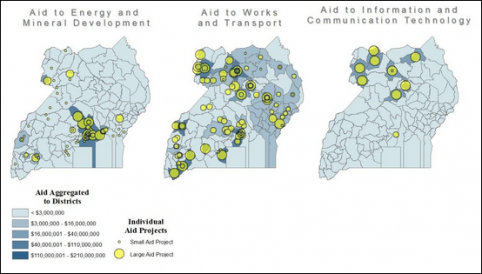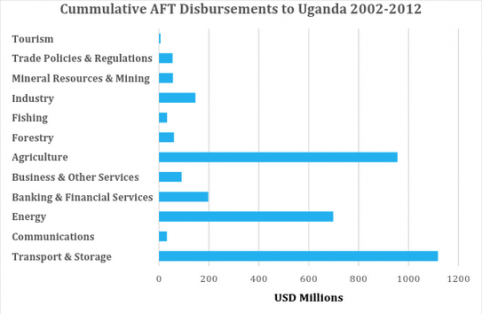
Bujagali Power Station under construction (RedPepper)
Trade liberalization is widely regarded to be a key factor in economic development. Its proponents argue that openness to market forces will increase the efficiency of resource allocation and lead to sustained economic development. On the basis of this belief, the World Bank and IMF have recommended market-oriented policy reforms, which developing countries have largely implemented over the past four decades.
However, the implementation of these reforms quickly revealed a lack of capacity in many least developed countries (LDCs) to gainfully participate in liberalized global trade. This is because LDCs face many constraints to trade, including but not limited to: weak and unstable productive capacities, poor market infrastructure, and an inability to meet required high quality standards for goods and services. These constraints have prevented many LDCs from reaping the full benefits of trade openness.
Recognizing these constraints, the World Trade Organization (WTO) launched the Aid for Trade (AFT) initiative in 2005 to coordinate international support for strengthening trade capacity in LDCs. For example, despite the recent suspension of aid to Uganda due to controversial passing of anti-gay legislation and corruption in the Office of the Prime Minister, Uganda received nearly USD $1 billion in aid for trade-related activities between 2009 and 2012. Yet little has been done to evaluate the performance of the trade-related aid.

Figure 1. Aid for Infrastructure Development (1988 – 2013), A Component of AFT (AidData)
In a recent study funded by the Economic Policy Research Center (in Kampala, Uganda) and published in AidData’s Working Paper series, we sought to correct this problem by looking at (a) how aid-for-trade disbursements align with Uganda’s national development priorities; (b) the impact of trade-related aid on the country’s capacity to trade; and (c) the emerging policy lessons of how to better enhance the impact of trade-related aid on the country’s capacity to trade.
Alignment of Aid for Trade Initiatives to Uganda Development Priorities
In the study, we found that trade-related aid generally reflects the needs of Uganda’s development priorities, which include: infrastructure development, energy sector development, and enhancing commercial agricultural production and productivity, as set out in the country’s National Development Plan. Figure 1, above, shows the geographic distribution of key Aid for Trade related sectors. Energy and mineral development projects are clustered around Kampala, Uganda’s capital and largest city. Works and transport aid is scattered across the country, while information and communication technology projects are concentrated in the North, Uganda’s poorest region. Aid disbursements to trade-related sectors over 2002-2011 are shown in Figure 2.

Figure 2. AFT Disbursements by Sector for Uganda (OECD-CRS, 2013)
A closer look at the breakdown of the aid funding by sector reveals that much of the aid money directed into transport infrastructure went into the construction of road networks, but almost none into lower cost rail and waterway infrastructure development. However, China is financing the construction of the standard gauge railway (SGR) that will connect Kenya, Uganda, Tanzania, Rwanda, Burundi, the Democratic Republic of Congo, and South Sudan. Launched by Kenya, Uganda and Rwanda, this project is part of the EAC Railway Master Plan designed to link up East and Central Africa’s otherwise inaccessible hinterland to trading hot spots in the region. In addition, no aid money or domestic funding went into construction of storage facilities, even though this could be critical in smoothing some export supply quantities.
The Government of Uganda also prioritized the development of the electrical power subsector to power economic growth in the country in line with the national development plan. This effort saw the commissioning of the 250 Megawatt Bujagali hydroelectric power dam in 2012, financed with aid support from the African Development Bank, World Bank,the European Investment Bank, and the Agha-Khan Foundation. Aid support in the development of the power subsector has stabilized electrical supply in the country and boosted productivity especially in the manufacturing sector. Access to stable electricity therefore represents an important recent achievement that involved aid support, though the cost of commercial electricity of USD $0.19 per unit remains relatively uncompetitive in the region.
Agriculture, which contributes nearly 60% to Uganda’s export receipts, received approximately USD $900 million between 2002 and 2011. However, low productivity and limited innovation in the sector shows that more support to agriculture would be extremely useful in strengthening trade capacity, especially in terms of developing irrigation infrastructure, storage facilities, and methods for boosting productivity.
The Impact of Overall Development Assistance
Our working paper examined the impact of overall official development assistance (ODA) on Uganda’s exports, imports, and trade balance from 1998 to 2011 using time-series analysis and data from the World Bank’s World Development Indicators.
We found that a one-percentage increase in ODA is associated with a 0.7 percent increase in exports and a 0.3 percent increase in imports. These values are statistically significant, and we control for variables that are consistent with the literature on estimating imports and exports, including GDP, the real effective exchange rate, among others. This finding suggests that aid has the potential to significantly impact Uganda’s export capacity. However, Uganda’s exports have continued to perform relatively weakly vis-à-vis imports leading to a widening deficit in the trade balance. This underscores the persistent dominance of other bottlenecks such as non-tariff barriers, high cost of production, and deficiency in quality and standards that continue to undermine Uganda’s export competitiveness.
Aid support has also enhanced policy capacity in Uganda. Specifically, aid support enabled Uganda to review the status of the trade sector and formulate its first national trade policy in 2007 and later national trade sector development strategy through the Uganda Program for Trade Opportunities and Policy. Uganda has now mainstreamed trade into its overall policy framework, the National Development Plan (NDP).
Four Next Steps: Enhancing the Impact of Aid for Trade in Uganda
The analyses suggest a number of actions that could be taken to improve the impact of aid for trade in Uganda.
First, our model implies that increasing aid to the trade sector may benefit Uganda’s capacity to trade. Second, aid should arguably be directed into sectors and subsectors that most directly increase the country’s competitiveness and capacity to trade. These critical areas for investment include: (a) regionally integrated road, rail, water, information and communications technology (ICT), energy and storage infrastructure; (b) trade facilitation reforms such as the East African Community Single Customs Territory and electronic single window; (c) the development of the country’s capacity to enhance productivity and competitiveness; and (d) developing capacity to ensure and certify the quality and standards of goods and services. The financing of these critical areas will very likely go a long way towards facilitating trade and building Uganda’s capacity for regional and global trade.
Third, another area that is becoming important is Uganda’s capacity for regional and multilateral trade negotiation. From 2002 to 2011, just over USD $1 million of aid, mostly from the EU and Japan, was directed into strengthening Uganda’s trade negotiation capacity. Although this represents good alignment between aid support and domestic financing needs, Uganda still has inadequate capacity in multilateral trade negotiations. This finding also highlights the need for national and regional options to bolster trade negotiation capacity. Trade negotiation capacity is likely to become key as Uganda’s production and supply capacity strengthens.
Fourth, AFT initiatives will likely be most successful when combined with policy ownership. Policy ownership will especially be critical in the crucial areas of production and productivity enhancement, the development of quality and standards capacity, investment in regionally integrated transportation, ICT, storage infrastructure, and trade facilitation.
Further details and policy suggestions can be found in the full study.
